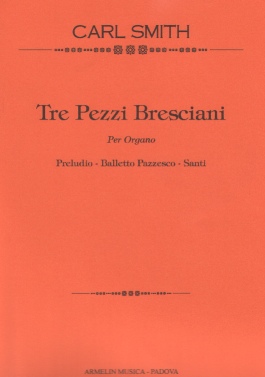Smith, Carl
Tre pezzi bresciani
Per Organo. Preludio - Balletto Pazzesco - Santi
€15,00
Organico:
AV 022
9790215804555
21x29,7
Armelin Musica
INTRODUZIONE ALLA PUBBLICAZIONE
I “Tre Pezzi Bresciani” sono stati composti per i miei amici dell’Associazione “Costanzo Antegnati” di Brescia. La prima esecuzione è
avvenuta sull’organo Serassi della chiesa di San Faustino. Tutti e tre sono stati composti per l’organo italiano antico, anche con pedaliera corta, senza bisogno di ance (o altro).
Il “Preludio senza Misura” è stato composto nello stile dei clavicembalisti del ‘600 e ‘700.
Il modo in cui sono disposte le note sul pentagramma suggerisce la velocità e la unghezza delle note e le legature indicano
quali sono tenute. Non c’è un tempo fisso e si
deve considerare l’acustica della chiesa.
Secondo l’uso dell’epoca, c’è una seconda
parte, su tema di Brahms con una battuta
regolare, prima del ritorno allo stile dell’inizio.
Il “Balletto Pazzesco” è uno scherzo per
flauto aperto di 4 piedi che usa canzoni per
bambini, temi, inni –inni americani, ecc.- in
una maniera piuttosto assurda. L’effetto è
migliore se si esagerano un po’ i ritmi.
“Santi”, l’ultimo pezzo, presenta in combinazione l’inno per la festa di Ognissanti “For All the Saints” e la canzone famosa di
New Orleans “When the Saints Go Marching
In”. Si dovrebbe cominciare col Principale
solo e finire con tutti i registri.
Questi pezzi sono stati composti da un
americano che per molti anni ha suonato i
bellissimi organi storici italiani. Spero che
piaceranno all’organista e al suo pubblico.
The “Tre Pezzi Bresciani” were written for
my good friends in the Associazione Costanzo
Antegnati in Brescia. The first performance
was on the Serassi organ in the church of San
Faustino in Brescia. All three pieces were
written for antique Italian organs, even those
with short pedalboards and no reed stops.
The “Preludio senza Misura” (Unmeasured
Prelude) is written in the style of the
seventeenth and eighteenth century
harpsichordists. The appearance of the notes
on the staff suggests the speed and the length
of the notes, and the slurs indicate which
should be held. There is no fixed tempo, and
one must take into account the effect of the
acoustics of the church. In the manner of the
period, there is a second section (which
employs a theme by Brahms) in strict tempo,
before a return to the unmeasured style of the
beginning.
The “Balletto Pazzesco” (Crazy Dance) is a
scherzo for the 4’ open flute so characteristic
of Italian organs, and it employs various American themes –hymns, children’s songs,
etc.- in a rather absurd manner. The effect of
the piece is better if the rhythms are exaggerated a bit.
“Santi” (Saints), the final piece, presents in
combination the great hymn for All Saints’
Day “For All the Saints” and the famous song
from New Orleans “When the Saints Go
Marching In”. It should begin with the
principal alone and conclude with full organ.
These pieces were written by an American
who has played the beautiful old Italian organs
for many years. I hope organists and their
audiences find the pieces enjoyable.
